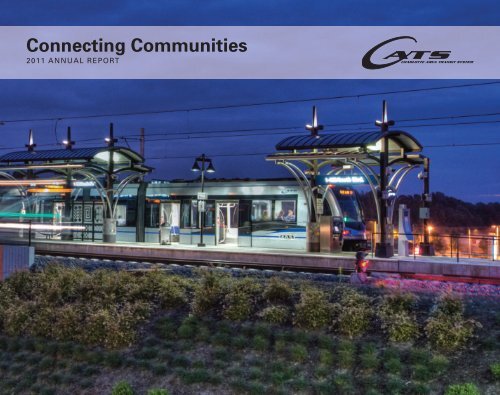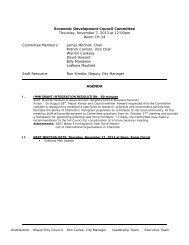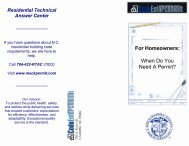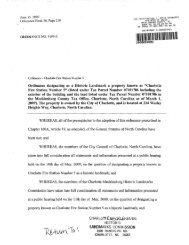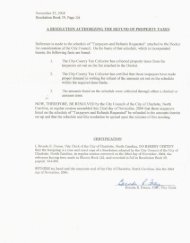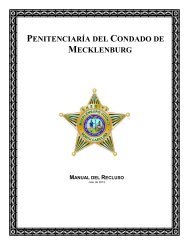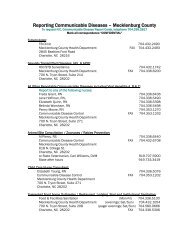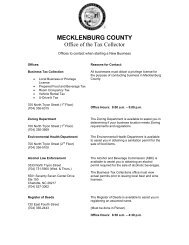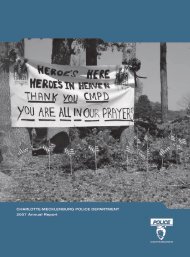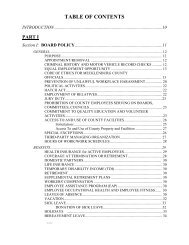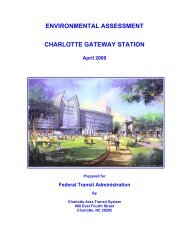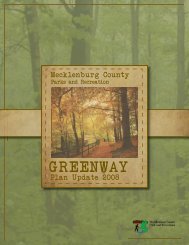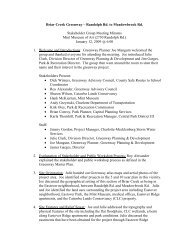Layout 1 - Charlotte-Mecklenburg County
Layout 1 - Charlotte-Mecklenburg County
Layout 1 - Charlotte-Mecklenburg County
You also want an ePaper? Increase the reach of your titles
YUMPU automatically turns print PDFs into web optimized ePapers that Google loves.
Connecting Communities<br />
2011 ANNUAL REPORT
Mission<br />
To improve the quality of life for everyone in the greater<br />
<strong>Charlotte</strong> region by providing outstanding communitywide<br />
public transportation services while proactively<br />
contributing to focused growth and sustainable regional<br />
development.<br />
Vision<br />
A steadily increasing share of transit competitive travel<br />
markets in the <strong>Charlotte</strong> region choose to use public<br />
transportation on a regular basis.<br />
The citizens of the region value public transportation<br />
as an important public service, which benefits the<br />
community as a whole by consistently providing<br />
exemplary service that meets diverse individual needs.<br />
Public transportation employees are seen and see<br />
themselves as committed, competent and motivated<br />
professionals of the region's premier public service.<br />
CATS is recognized both locally and nationally for its<br />
contribution to effective and innovative regional growth<br />
that is community focused and sustainable.<br />
Goals<br />
• Customer Service Focus: Provide safe, high-quality<br />
transportation services to all customers and support<br />
our employees in that endeavor.<br />
• System Development: Expand and enhance public<br />
transportation services to retain current customers<br />
and attract new ones by providing services that meet<br />
customer and community needs while supporting<br />
transit-oriented and pedestrian-friendly land use<br />
patterns.<br />
• Fiscal Responsibility: Ensure cost-effective, efficient<br />
and responsible use of resources and aggressively<br />
pursue funding partnerships to supplement local<br />
resources.<br />
• Community Benefits: Provide social, economic and<br />
environmental benefits to the community through<br />
system operations and improvements, and promote<br />
community awareness of these contributions.<br />
• Prepare for the Future: Pursue process improvements,<br />
business practices, and technologies that will support<br />
cost-effective and customer-friendly service delivery<br />
in the future.<br />
• Invest in Employees: Provide training and career<br />
development support that enhances employees'<br />
ability to perform their jobs and be prepared for<br />
promotional opportunities.
Table of Contents<br />
•1• Letters to the Community<br />
•3• Metropolitan Transit Commission<br />
•5• CATS Leadership Team<br />
•6• Operations<br />
•7• Service<br />
•11• Safety & Security<br />
•12• Development<br />
•16• A Decade of Accomplishments<br />
•17• Fast Facts<br />
•18• Financial Summary
Having grown up in <strong>Charlotte</strong>, I<br />
have a unique personal connection<br />
to the people and communities<br />
served by the <strong>Charlotte</strong> Area<br />
Transit System. As chairman<br />
of the Metropolitan Transit<br />
Commission (MTC), it is my<br />
responsibility to make sure our<br />
decisions help our communities<br />
thrive. Considering the current<br />
economic climate, the MTC<br />
focused much of its energy on our<br />
responsibility to work within our<br />
means without jeopardizing our<br />
long-term transit vision. Our<br />
approach was balanced and sustained with cost reduction measures.<br />
As the year began it was clear that the decline in sales tax revenue since<br />
2008, due to the continuing economic downturn, was making the long-range<br />
plan unachievable in its current form. The MTC instructed CATS to develop<br />
a more affordable Blue Line Extension (BLE) project to fit within the new<br />
budgetary realities; seek an innovative public private partnership to advance<br />
the LYNX Red Line; and maintain core services while providing for a safe,<br />
reliable, and attractive transit system. By mid-year the MTC reviewed and<br />
approved a new BLE plan, reducing the project's cost by 20 percent while<br />
advancing the project through 65 percent design and a projected opening<br />
date in early 2017. The MTC also established the LYNX Red Line Task<br />
Force, which has proposed innovative implementation and funding<br />
strategies to advance the LYNX Red Line. The MTC will consider this new<br />
framework during the next fiscal year.<br />
Another component of our approach required the assessment of new<br />
potential sources of revenue. As a result, the MTC approved allowing<br />
advertisements on the exterior of CATS vehicles, in transit centers, on transit<br />
schedules, other venues and naming rights. These additional revenues will<br />
aid in handling increased costs and sluggish sales receipts. In addition, I<br />
Mayor Anthony Foxx<br />
Metropolitan Transit Commission Chairman<br />
•1•<br />
am pleased to report that both the FY2012 Transit Operating Budget and<br />
FY2012-2016 Capital Investment Plan were unanimously approved.<br />
The City of <strong>Charlotte</strong> has also moved to advance the long-term transit vision<br />
with a successful application for the Federal Urban Circulator Grant, which<br />
is returning the streetcar to <strong>Charlotte</strong> for the first time in more than 60 years.<br />
While the capital cost of this 1.5 mile streetcar will be born out of City<br />
capital funds and a remarkable two-thirds share of federal proceeds, this<br />
improvement reduces the long-term costs of the 2030 Transit Corridor<br />
System Plan by eliminating this stretch of streetcar from the half-cent<br />
sales tax. This investment also deepens our area’s reputation as transit<br />
friendly.<br />
None of these successes would have been possible without CATS CEO<br />
Carolyn Flowers, who was recently named one of <strong>Charlotte</strong>'s Top 25<br />
Outstanding Business Women by the <strong>Charlotte</strong> Business Journal. The award<br />
is given to professional women who have led special projects, developed<br />
new products and helped their businesses to stand out, among other factors.<br />
Within less than 16 months of arriving at CATS, Ms. Flowers secured<br />
support from Washington, D.C. for the LYNX Blue Line Extension,<br />
garnered several visits to <strong>Charlotte</strong> by Secretary of Transportation<br />
Ray LaHood, and sought new funding sources for the organization through<br />
advertising. She was instrumental in reducing the project scope of the Blue<br />
Line Extension by $200 million, while maintaining a 95 percent customer<br />
satisfaction rating and a budget with sales tax receipts down 20 percent.<br />
Congratulations to Ms. Flowers and we look forward to her continued<br />
leadership.<br />
The larger a region grows, the more diverse the transportation options it<br />
needs to keep moving in the right direction to sustain the economy. It is<br />
challenging to sustain current services and implement new ones with fewer<br />
resources than previously. Our shared circumstance and vision, force us to<br />
act as a community in order to serve our community. I can't think of a better<br />
road to travel than one we have built together.
I have always believed in<br />
the power of a shared vision.<br />
Of course, achieving that<br />
vision requires a resounding<br />
commitment to teamwork and<br />
adaptability. This year, in<br />
particular, CATS has<br />
demonstrated what we can<br />
accomplish when we connect<br />
with the needs of the<br />
communities we serve to solve<br />
the challenges we all face. The<br />
sluggish economy continued to<br />
affect our ability to add new<br />
services at the pace in previous<br />
years and advance the rapid transit plan approved in 2006. However, through<br />
creative public-private partnerships, new revenue sources and value<br />
engineering the LYNX Blue Line Extension, we were able to provide some<br />
service enhancements, maintain our core services and advance the rapid transit<br />
plan.<br />
To the community’s delight, the Gold Rush service was enhanced this year<br />
through an expansion of the public-private partnership with <strong>Charlotte</strong> Center<br />
City Partners to encompass Johnson C. Smith University, Central Piedmont<br />
Community College and Presbyterian Hospital. Ridership on the Gold Rush<br />
has increased since expanding this service, demonstrating the communities’<br />
desire for public transit. Ridership overall rebounded by 2.2 percent from the<br />
previous year with neighborhood and mainline routes experiencing the largest<br />
increases while services linked to uptown employment, like Express routes<br />
and the LYNX service, remained flat. We were able to increase ridership for<br />
the year with an excellent on-time performance across all services: 87 percent<br />
for bus and 99 percent for rail. We were also recognized by the North Carolina<br />
Department of Transportation as the safest bus and para-transit system in<br />
the state.<br />
Carolyn Flowers<br />
<strong>Charlotte</strong> Area Transit System Chief Executive Officer<br />
•2•<br />
In January, after public input and value-engineering sessions, we presented a<br />
more economically fit cost estimate for the LYNX Blue Line Extension,<br />
reducing the project by $200 million. The adjustments to the project, which<br />
includes the shortening of the line by approximately 1.2 miles, still maintains<br />
the connection of the UNC <strong>Charlotte</strong> Campus to center city <strong>Charlotte</strong>. Staff<br />
worked with the Red Line Task Force Committee and consultants to advance<br />
the Red Line and develop a new framework for funding the design,<br />
construction and operation of the line which will be presented in the fall<br />
of 2011.<br />
After nearly a decade of absence CATS started accepting advertisements on<br />
the exterior of CATS vehicles in an effort to offset operating expenses. This<br />
new program provides a $5 million revenue guarantee through 2016 with<br />
options to expand revenue venues in the future.<br />
We have been pleased with our successes, but we are extremely proud to hear<br />
how our customers think we’re doing. After conducting the first bus and rail<br />
passenger satisfaction survey in three years, customers gave CATS high marks<br />
on the quality of service, value to the community, management of the transit<br />
system and planning for the future.<br />
Is it a challenging time for all of us? Without a doubt. But as we’ve seen<br />
throughout the year, challenges breed opportunities when we all work together<br />
to solve them. By connecting with our communities and each other, we will<br />
continue to deliver one of the safest, cleanest, most reliable transit systems in<br />
the country.
Metropolitan Transit Commission (MTC)<br />
The MTC is CATS’ governing board and is responsible for reviewing and recommending all long-range public transportation<br />
plans. The MTC reviews the transit system’s operating and capital programs and sets policies that guide the transit system’s<br />
use of public monies. The MTC is composed of voting and non-voting members. The voting members are the mayors and<br />
managers of the City of <strong>Charlotte</strong>; <strong>Mecklenburg</strong> <strong>County</strong>; and the six towns in <strong>Mecklenburg</strong> <strong>County</strong>: Cornelius, Davidson,<br />
Huntersville, Matthews, Mint Hill and Pineville; and a board member from the North Carolina Department of Transportation.<br />
To ensure regional involvement, the MTC includes five non-voting members representing local governments outside of<br />
<strong>Mecklenburg</strong> <strong>County</strong> and one non-voting member from the South Carolina Department of Transportation. The MTC has two<br />
citizen committees which provide input on short-term and long-term transit plans.<br />
Pictured from left to right: Front Row – Brian Welch, Mint Hill Town Manager; Sarah B. Nuckles, SCDOT Representative; John Woods, Mayor of Davidson; Anthony<br />
Foxx, Mayor of <strong>Charlotte</strong>, MTC Chairman; Jennifer Roberts, Chairman of the <strong>Mecklenburg</strong> <strong>County</strong> Board of Commissioners; James Taylor, Mayor of Matthews; Curt<br />
Walton, <strong>Charlotte</strong> City Manager and Leamon Brice, Davidson Town Manager. Back Row – Jill Swain, Mayor of Huntersville; Ralph Messera, Town of Matthews; Anthony<br />
Roberts, Cornelius Town Manager; Greg Ferguson, Huntersville Town Manager; John Collett, NCDOT Representative; Bill Thunberg, Mooresville Designee; Mike Rose,<br />
Pineville Town Manager and Jeff Tarte, Mayor of Cornelius. Not Pictured – Mary Barker, CTAG Co-Chair; Ted Biggers, Mayor of Mint Hill; Hazen Blodgett, Matthews<br />
Town Manager; Tom Cox, CTAG Co-Chair; Douglas Echols, Jr., Mayor of Rock Hill; George Fowler, Mayor of Pineville; Harry Jones, <strong>Mecklenburg</strong> <strong>County</strong> Manager;<br />
Bobby Kilgore, Mayor of Monroe; Chris Montgomery, Mayor of Mooresville; Scott Padgett, Mayor of Concord; Rick Sanderson, TSAC Chairman; Erskine Smith, Town<br />
Manager of Mooresville and Jenny Stultz, Mayor of Gastonia.<br />
•3•
Citizens Transit Advisory Group (CTAG)<br />
CTAG reviews long-range transit system planning and proposed operating<br />
and capital programs from the community’s perspective and makes<br />
recommendations to the MTC. This advisory board is made up of members<br />
of the community appointed by the <strong>Mecklenburg</strong> <strong>County</strong> Board of<br />
Commissioners, the <strong>Charlotte</strong> City Council, each of the six towns, and the<br />
<strong>Charlotte</strong>-<strong>Mecklenburg</strong> Board of Education. It may include no elected<br />
officials, and its members serve staggered two-year terms.<br />
Transit Services Advisory Committee (TSAC)<br />
TSAC reviews, makes recommendations, and provides input into<br />
short-range transit operations. The committee focuses on day-to-day<br />
operations of the transit service to ensure that it meets the needs of the<br />
community. It makes recommendations to the MTC on issues within its<br />
sphere of interest and acts as a vehicle to promote public involvement on<br />
short-term transit planning. TSAC is made up of representatives appointed<br />
by the City of <strong>Charlotte</strong>, the <strong>Mecklenburg</strong> <strong>County</strong> Board of Commissioners,<br />
and the six towns.<br />
•4•<br />
Public Meetings<br />
All public meetings are held at:<br />
<strong>Charlotte</strong>-<strong>Mecklenburg</strong> Government Center<br />
600 East Fourth Street<br />
<strong>Charlotte</strong>, NC 28202<br />
Metropolitan Transit Commission<br />
Fourth Wednesday of each month<br />
5:30 pm – 7:30 pm<br />
Room 267<br />
Citizens Transit Advisory Group<br />
Third Tuesday of each month<br />
7:30 am – 9:00 am<br />
Basement Level, CH-14<br />
Transit Services Advisory Committee<br />
Second Thursday of each month<br />
4:00 pm – 5:30 pm<br />
Basement Level, CH-14
Leadership Team<br />
CATS’ Leadership Team is charged with managing the day-to-day business of the organization. It is made up of managers<br />
from each CATS division: Executive, Finance, Development, Transit Support Services, Marketing and Communications, and<br />
Operations.<br />
Pictured from left to right: Wanda Braswell, Executive Assistant to the Chief Executive Officer; John Trunk, Director of Transit Support Services; Rocky Paiano, General<br />
Manager of Rail Operations; Olaf Kinard, Director of Marketing and Communications; Gracie Myers, Transit Human Resource Manager; John Muth, Deputy Director;<br />
John Joye, Senior Assistant City Attorney; Carolyn Flowers, Chief Executive Officer; David McDonald, Transit Planning Manager; Pete Wallace, General Manager of<br />
Special Transportation and Vanpool; Dwayne Pelfrey, General Manager of Bus Operations; Larry Kopf, Chief Operations Planning Officer; Celia Gray, Quality Assurance<br />
Manager and Dymphna Pereira, Chief Financial Officer.<br />
•5•
OPERATIONS<br />
Ridership<br />
Public transit plays a vital role in the communities CATS serves – providing access<br />
to jobs, protecting the environment, contributing to economic development,<br />
saving energy, reducing pollution, helping to alleviate traffic, and creating jobs.<br />
However, the combination of a sluggish economy and no growth in the local sales<br />
tax receipts since 2008 placed demands on an already stretched transit investment.<br />
Our goal for the year was to maintain our core services, improve the reliability of<br />
service and provide our customers with a safe ride. We are proud to say that we<br />
accomplished those goals and attracted more riders. Total ridership for FY2011<br />
was up 2.2 percent to 24,900,919, the second-highest ridership year behind only<br />
the gas crisis of FY2009.<br />
People relied on Community Circulator routes that provide a connection to local<br />
mainline service for access to jobs and employment. It’s no wonder that the<br />
biggest boost in ridership during the year came from the Community Circulator<br />
routes, which were up 8.3 percent. In fact, bus ridership, led by Community<br />
Circulator and Local bus services, provided a strong 3.6 percent increase in<br />
ridership during the year.<br />
Ridership (In Millions)<br />
FY11<br />
24,900,919<br />
FY10<br />
24,355,191<br />
FY09<br />
26,034,078<br />
FY08<br />
23,199,350<br />
FY07<br />
19,757,737<br />
FY06<br />
19,156,590<br />
0 2 4 6 8 10 12 14 16 18 20 22 24 26 28<br />
•6•
Services with a high percentage of riders who work in uptown<br />
professional positions continued to show decreases or remain flat for<br />
the year. Ridership on the LYNX Blue Line was down a fraction of a<br />
percent as compared to FY2010 mainly due to the lack of a strong<br />
employment rebound and less discretional spending by consumers to<br />
attend sporting and uptown events. However, the LYNX Blue Line<br />
continues to surpass original ridership projections. In FY2011, LYNX<br />
averaged more than 14,600 weekday trips. Express routes showed the<br />
most decrease. They were down 8.6 percent due to a reduction in<br />
service trips because of budget cuts and a sluggish employment<br />
rebound. But, ridership appeared to be leveling off as the fiscal year<br />
ended.<br />
Gas prices began to steadily rise in late winter, making public transit<br />
the most cost effective way to travel around the region. As a result,<br />
riding CATS, carpooling, vanpooling and biking saved individuals an<br />
average of $2,416 annually, or $200 per month, on their daily commute<br />
and even more for other trips.<br />
Service<br />
Though funding remained tight during the year, CATS was able to<br />
make service enhancements by obtaining specialized grants and by<br />
expanding public-private partnerships. Every new service that was<br />
added or expanded this year was done so with the single goal of<br />
increasing the mobility options in the community. And, the more<br />
options we provide, the more connected area residents will feel to the<br />
city, the region and even the world around us.<br />
•7•
New Services<br />
94 – Matthews/Mint Hill Shuttle<br />
This year saw the introduction of Route 94–Matthews/Mint Hill Shuttle serving the Lawyers Glen Assisted Living Center, the<br />
Levine Senior Center and Blessed Assurance Adult Day Care. This new service was implemented with the help of the North<br />
Carolina Transportation for Elderly Persons and Persons with Disabilities Grant. It is a vital service for all transit customers,<br />
but it is especially important for keeping seniors and disabled members of the community linked to the greater <strong>Charlotte</strong> region.<br />
Gold Rush Expansion<br />
CATS’ popular Center City circulator, the Gold Rush, was extended this year to encompass Johnson C. Smith University, Central<br />
Piedmont Community College, and Presbyterian Hospital through funding provided by these organizations. The expansion<br />
connects students, citizens, and visitors to a greater variety of businesses, educational and employment opportunities in Center<br />
City <strong>Charlotte</strong>.<br />
Continued Growth On Specialized Services<br />
In addition to the traditional concept of geographic communities, CATS is just as<br />
concerned with providing transportation options for specific communities of<br />
people, including airline travelers, NASCAR fans and those with special needs.<br />
While not everyone will utilize the services, they are nonetheless vital to the<br />
region’s continued economic growth and connectivity.<br />
Sprinter<br />
Sprinter, CATS’ first enhanced bus service that connects travelers with <strong>Charlotte</strong><br />
Douglas International Airport, celebrated its one-year anniversary in FY2011. Over<br />
the course of the year, ridership on Sprinter increased 20.9 percent over the<br />
previous service. The service uses a fleet of hybrid buses that produces fewer<br />
emissions and accommodates travelers with luggage.<br />
•8•
79x – Concord Mills Express<br />
Hundreds of NASCAR fans let CATS do the driving to the two<br />
races that occur in May and October at the <strong>Charlotte</strong> Motor<br />
Speedway. Ridership increased 35.7 percent over last year<br />
for the May races. In October the <strong>Charlotte</strong> Motor Speedway<br />
used wrapped buses to help promote the race while<br />
providing CATS with a new revenue source.<br />
FY2007-FY2012 <strong>County</strong>wide Services Plan Review<br />
A newly wrapped bus makes a lap on the <strong>Charlotte</strong> Motor Speedway.<br />
As CATS entered the final year of the current <strong>County</strong>wide<br />
Transit Services Plan, staff conducted 32 meetings throughout the community in preparation to update the plan to cover<br />
FY2013-FY2018. The plan is designed to provide guidance over a five-year period to help make decisions related to new bus<br />
routes, adjustments to existing bus routes, and locations of new park and ride lots and/or transit centers. The public’s input<br />
will play an important role in designing services that meet their transportation needs and in developing services that best serve<br />
the region.<br />
Special Transportation Service (STS)<br />
Our Special Transportation Service experienced a five-fold increase in the number of ADA Functional Assessments received<br />
due to changes and resource constraints at other local human services agencies and providers. Many former transportation<br />
clients of the human services agencies are now certified as eligible to ride STS. Although STS did not experience an increase<br />
in ridership for the year, it did have an increase in ADA related trips in the ADA service area, leaving less capacity to provide<br />
trips outside of the required ADA service area.<br />
Even with the increase in customers, we remain committed to helping those with disabilities stay connected to the communities<br />
in which they live, work, and play. It is also important that we deliver these citizens to their destinations safely and comfortably.<br />
CATS was able to do that with the purchase of 20 new STS vehicles. With the help of the Clean Fuels Grant program, which<br />
supports emerging clean fuel and advanced propulsion technology for transit buses, CATS replaced older, less-efficient STS<br />
vehicles with vehicles that emit 56 percent less carbon dioxide, get more miles per gallon, only require preventative<br />
maintenance every 10,000 miles, and have an increased lifespan up to seven years and 200,000 miles.<br />
•9•
Technology<br />
CATS customers are becoming more tech savvy and desiring<br />
more and more information at their fingertips through different<br />
technologies. Building on this foundation, CATS made several<br />
customer-focused enhancements making it easier and more<br />
convenient to ride. At the beginning of FY2011 CATS launched a newly<br />
designed and improved website with better navigation, quicker access to frequently accessed information, and language<br />
translation. As the <strong>Charlotte</strong> region’s population continues to grow and become more diverse, CATS is connecting with an<br />
increasingly diverse ridership community through the use of a new, free language translation tool provided via Google<br />
Language. Over 40 different languages are supported with this enhancement including the eight most spoken languages in<br />
the <strong>Charlotte</strong> area: French, German, Hindi, Korean, Portuguese, Russian, Spanish and Vietnamese. According to the recently<br />
released 2010 U.S. Census Bureau numbers, <strong>Mecklenburg</strong> <strong>County</strong>’s population increased 32.2 percent since 2000 to 919,600.<br />
More than 111,900 citizens are Hispanic, and 42,350 are of Asian descent. Over 80,500 citizens in <strong>Mecklenburg</strong> <strong>County</strong> identify<br />
themselves as “some other race” or “two or more races.” CATS noticed the expanding diversity of our riders in the 2010<br />
Customer Satisfaction Survey, and introduced the translation tool to make commuting even easier for more passengers.<br />
Building on the popularity of the LYNX Blue Line mobile app, CATS introduced a free “Ride CATS” mobile app this year to<br />
make riding public transit even easier. The new app estimates the next four arrival times and the next three arrival times at<br />
any transit stop for any CATS bus route or LYNX train. “Ride CATS” is available on many smartphone platforms including:<br />
iPhone, Droid, Blackberry and any web-enabled phone.<br />
“Ride CATS” mobile app allows customers to:<br />
• Save their most frequented stops and routes for quick access<br />
to get the next bus/train trip<br />
• View an entire route and stops on a Google map<br />
• View a complete stop listing with an option to display it on a<br />
Google map<br />
• Plan a trip through Google Transit<br />
• View content in Spanish and English<br />
• Send feedback to CATS Customer Service •10•
SAFETY & SECURITY<br />
Accident Rates<br />
Bus Preventable Accidents (Per 100,000 Miles)<br />
1.20<br />
1.00<br />
.80<br />
.60<br />
.40<br />
.20<br />
0<br />
.93<br />
.88<br />
.78 .74<br />
FY03 FY04 FY05 FY06 FY07 FY08 FY09 FY10 FY11<br />
New Safety And Security Measures<br />
.55<br />
CATS prides itself on being one of the safest transit systems in the country. This is due to the proactive safety and security<br />
enhancements undertaken every day. CATS increased the number of sworn law enforcement officers patrolling and riding<br />
the transit system, including LYNX. The sworn law enforcement officers provide one of the highest levels of security and have<br />
full arrest authority on CATS property and vehicles. In addition, the sworn officers assist in checking fares, helping to keep our<br />
fare evasion rate at one of the lowest in the country at 1.9 percent. Coupled with our current use of security cameras on<br />
vehicles, at platforms, and throughout CATS-owned park and ride lots, these efforts produced a reduction in reported incidents<br />
along the LYNX line by 33 percent.<br />
•11•<br />
.40<br />
.44<br />
.40<br />
.35
But, the good news doesn’t stop there. Every day customers rely on us<br />
to transport them safely to their destinations. So, it should be no<br />
surprise that CATS experienced a 14 percent decrease in preventable<br />
accidents over FY2010. And, others took notice. Our Bus Operations<br />
Division was named the Safest Large Bus System in the state, and STS<br />
won the award for the Safest Small Bus System in the state for the third<br />
consecutive year. At the State Roadeo driving and maintenance<br />
competition, STS drivers brought home the Overall System Trophy for<br />
the fifth consecutive year.<br />
DEVELOPMENT<br />
Blue Line Extension<br />
Since 2008, when the Great Recession began, the local sales tax receipts<br />
have not exceeded the 2005 level, making the long-range plan<br />
established in 2006 unachievable. The loss of growth in the sales tax<br />
has resulted in a projected $2.2 billion gap in revenue through 2035<br />
versus the sales tax revenue projected in 2006. Taking the new<br />
economic realities into account, CATS developed a new financial plan to advance rapid transit and bus services in the region<br />
through 2035. The MTC reviewed the new financial plan and instructed CATS to develop an “affordable” BLE project by<br />
reducing the capital costs by 20 percent while maintaining a viable service that will open in early 2017 and attract ridership.<br />
MTC members unanimously approved changes to reduce BLE project costs along with an updated financial plan for the entire<br />
transit system. The BLE project will now terminate at UNC <strong>Charlotte</strong> rather than at I-485, removing 1.2 miles of alignment and<br />
two stations. To accommodate increased ridership at other stations, the project will include a parking deck at the JW Clay<br />
Boulevard Station and a combination of deck and surface parking at the University City Boulevard Station.<br />
•12•<br />
CATS fare inspectors patrol LYNX trains,<br />
platforms and stations.
Other changes to the project include an initial reduction in service<br />
frequency by operating two-car trains every 7.5 minutes and three-car<br />
trains every 10 minutes, instead of two-car trains every six minutes. And,<br />
surface lots will be constructed at the Sugar Creek station rather than a<br />
parking deck. The proposed park and ride lots at the Tom Hunter and<br />
McCullough Stations will not be built. And, the project will not build a light<br />
rail vehicle maintenance facility at the Norfolk Southern Intermodal Site on<br />
North Brevard Street. It will, however, allow for an upfit of the existing<br />
South Boulevard maintenance facility. CATS continued to progress the<br />
65 percent project design plans as the Final Environmental Impact<br />
Statement (FEIS) was developed. The FEIS evaluates the social, economic,<br />
environmental and transportation effects associated with the BLE project.<br />
The FEIS is scheduled to be published in<br />
CASCADE/NC 15<br />
October 2011 with a record of decision to follow in December. Taking this schedule into<br />
MOORESVILLE<br />
MOORESVILLE<br />
account, both <strong>Charlotte</strong> City Council and the MTC authorized the negotiation of the State Full<br />
Funding Grant Agreement with NCDOT for the state’s 25 percent funding share of the project.<br />
Red Line Commuter Rail (North Corridor)<br />
A Red Line Task Force was formed to advance the FY2011 Red Line Work Plan over the next<br />
18-24 months. Their main focus is on developing a framework to address the funding gap<br />
created because the project does not meet current Federal New Starts criteria. The North<br />
Carolina Department of Transportation provided a consultant resource to collaborate with the<br />
task force on the work plan. During the year the task force identified potential cost savings<br />
through elimination or deferment of project items. Initiatives were started to create a<br />
public-private partnership model along the line to assist in generating additional funding to<br />
build and maintain the line. The task force plans to present this framework to the MTC in early<br />
FY2012.<br />
•13•
<strong>Charlotte</strong> Streetcar Project<br />
Due to the economic realities of reduced sales tax revenue since 2008, the<br />
advancement of the streetcar project had been delayed. In July, the City of<br />
<strong>Charlotte</strong> was approved to receive a $24.99 million grant from the Federal<br />
Transit Administration (FTA) for the completion of a 1.5-mile starter segment<br />
of the <strong>Charlotte</strong> Streetcar Project, which will connect the Elizabeth Avenue<br />
Business Corridor with the <strong>Charlotte</strong> Transportation Center in Uptown.<br />
CATS’ role in the project will be to support the City’s Engineering & Property<br />
Management Department in the design and construction of the service, as<br />
well as operate the service once it is ready in 2015.<br />
In June, preliminary engineering, which advanced the project design to the 30 percent level, was completed. This<br />
accomplishment allowed the City to develop a reliable cost estimate and schedule for the project. The Streetcar team finalized<br />
an update to the Environmental Assessment (EA) and submitted the Draft EA to the FTA for review. Also in June, the FTA<br />
completed their review process and a Finding of No Significant Impact was issued. The FTA has discussed their desire to<br />
accelerate the beginning of construction from March 2013 to December 2012. The FTA is also considering a prototype streetcar<br />
from Kinkisharyo, a Japanese rail car builder, which was tested and demonstrated in <strong>Charlotte</strong> in January. This streetcar is a<br />
100-percent low-floor hybrid-powered car that was put on public display for several days.<br />
The North Davidson Bus Facility includes a work of art titled:<br />
Wheels on the Bus in 7 Cymatic Sonatas.<br />
North Davidson Bus Facility Renovation &<br />
Expansion Project<br />
The North Davidson Bus Facility Renovation Project is funded by the<br />
American Recovery and Reinvestment Act of 2009 through the Transit<br />
Capital Assistance Urbanized Program. North Carolina’s largest<br />
stimulus project will improve operations by updating the condition of<br />
the 29-year-old facility while providing sufficient space and support for<br />
up to 200 transit buses. The renovation includes upgrades to the<br />
administration/operations and maintenance buildings as well as the<br />
•14•<br />
U.S. Secretary of Transportation Ray LaHood visits<br />
<strong>Charlotte</strong> to praise the <strong>Charlotte</strong> Streetcar Project.
Construction workers erect a wall at the<br />
North Davidson Bus Facility.<br />
<strong>Charlotte</strong> Gateway Station<br />
The <strong>Charlotte</strong> Gateway Station (CGS) Project is part of a larger, multi-modal<br />
development being led by the Rail Division of the State of North Carolina. The<br />
CGS/Multi-Modal Project is envisioned to serve Amtrak train service, Greyhound<br />
and CATS’ Red Line (commuter rail), Gold Rush, and Sprinter services between<br />
uptown and <strong>Charlotte</strong> Douglas airport, as well as CATS local and express bus<br />
routes.<br />
In order to develop future operating scenarios and estimate bus capacity<br />
requirements, CATS completed an Access and Circulation Study. CATS will<br />
continue to collaborate with the State of North Carolina during the coming fiscal<br />
year to advance the CGS/Multi-Modal Project through design development and<br />
phasing alternatives.<br />
construction of a new, multi-level staff parking garage. The facility will<br />
be more energy-efficient with upgraded plumbing, passive lighting<br />
systems, and the replacement of exterior finishes that allow for better<br />
temperature control. The building’s new eye-catching exterior also<br />
helps strengthen the connection between the facility and the<br />
surrounding community. In addition, the changes allow CATS Special<br />
Transportation Service to relocate to the North Davidson Bus Facility.<br />
This project enhanced the community in more ways than one. With the<br />
use of stimulus funds, approximately 200 jobs were created. Citizens<br />
were able to work and provide for their families while improving the<br />
gateway to the North Davidson neighborhood.<br />
•15•<br />
<strong>Charlotte</strong> Gateway Station Rendering
A DECADE OF ACCOMPLISHMENTS<br />
While this is an annual report, we wanted<br />
to share how investment in the half-cent<br />
sales tax over the last ten years has<br />
benefitted the community and provided<br />
greater connectivity for the region.<br />
In addition to a 75 percent increase in<br />
routes, the sales tax has allowed us to<br />
expand service hours and frequency. Now<br />
riders can access that information at any<br />
stop. CATS has installed eye-level displays<br />
at its 3400 stops, which tell citizens the<br />
previous major timepoint listed on the<br />
route schedule. We’ve improved safety<br />
and reliability, particularly for the disabled<br />
community. All CATS vehicles are now<br />
wheelchair-accessible, providing citizens<br />
with secure, dependable transportation<br />
and freedom of mobility.<br />
Customer amenities have significantly increased throughout the system. Clean, comfortable community transit centers have<br />
been added in the Beatties Ford, Eastland and SouthPark areas. CATS has increased the number of shelters, system-wide to<br />
300. We also took care to ensure those shelters fit in to the fabric of the community and included public art. CATS installed<br />
variable message signage at Sprinter stops and park and ride lots. And, citizens can now ride their bikes to a stop and take<br />
them on a vehicle. The majority of CATS buses and all LYNX trains are equipped with bike racks giving customers the ability<br />
to “rack and ride.”<br />
•16•
Accident rates have been reduced by 64 percent over the last nine years, and neighborhoods are connected like never before.<br />
Thanks to the half-cent sales tax, the LYNX Blue Line serves over 15,000 passengers a day, and development along the line<br />
through 2015 is estimated to generate $16 million annually in property taxes – up from $6 million in 2003.<br />
Customers responded to CATS efforts to provide them with a safer, more comfortable and more convenient commute. This<br />
was evident because ridership increased from 14.6 million in FY02 to 24.9 million in FY11. With this fact CATS looks forward<br />
to the next decade. Our commitment to our customers will not wane; it will only grow.<br />
Fast Facts<br />
CATS uses a variety of vehicles to provide millions of trips to the citizens of the <strong>Charlotte</strong> region.<br />
Fast Facts<br />
Revenue Hours<br />
Revenue Miles<br />
Employees<br />
Ridership<br />
Fleet<br />
Forty-Foot Buses<br />
Over The Road Buses<br />
Shuttle Buses<br />
Trolley Buses<br />
Paratransit Shuttles/Vans<br />
Vanpool Vans<br />
Light Rail/Vintage Trolley<br />
Fleet Total<br />
*Includes 36 frozen positions<br />
FY2006<br />
956,534<br />
15,137,798<br />
274<br />
19,156,590<br />
173<br />
91<br />
44<br />
20<br />
91<br />
100<br />
5<br />
524<br />
FY2007<br />
960,450<br />
15,542,847<br />
365<br />
19,757,737<br />
173<br />
91<br />
42<br />
20<br />
93<br />
93<br />
20<br />
532<br />
•17•<br />
FY2008<br />
1,021,623<br />
16,689,718<br />
377<br />
23,199,350<br />
181<br />
91<br />
50<br />
20<br />
84<br />
101<br />
20<br />
547<br />
FY2009<br />
1,034,940<br />
17,013,729<br />
377*<br />
26,034,078<br />
161<br />
102<br />
41<br />
20<br />
84<br />
81<br />
20<br />
509<br />
FY2010<br />
997,733<br />
15,617,247<br />
351<br />
24,355,191<br />
169<br />
91<br />
43<br />
20<br />
84<br />
71<br />
23<br />
501<br />
FY2011<br />
994,220<br />
15,927,116<br />
345<br />
24,900,919<br />
169<br />
91<br />
43<br />
20<br />
85<br />
99<br />
23<br />
530
FINANCIAL SUMMARY<br />
In FY2011 CATS continued to fulfill its mission of providing outstanding community-wide public transportation services to 24.9<br />
million passengers while proactively contributing to focused growth through advancement of the LYNX Blue Line Extension<br />
and Red Line projects and sustainable regional development.<br />
FY2011 Financial Highlights<br />
• On June 30, 2011, CATS closed FY2011* with an unaudited fund balance of $111.2 million which exceeds the<br />
Financial Policies objective by 11.2%.<br />
• Actual operating cost of $96.8 million was 5% below the adopted budget of $101.5 million. The $5.1 million<br />
reduction was achieved despite absorbing a 13% increase in fuel cost, with no reductions in service hours or<br />
workforce.<br />
• CATS applied for 10 competitive grant opportunities offered by the U.S. Department of Transportation and was<br />
successful in receiving awards of $8.8 million. These funds are additions to the capital program and budget.<br />
• The Blue Line Extension light rail project completed a value engineering process which reduced the overall<br />
project cost at 30% by just over 10% in year-of-expenditure dollars as compared to the cost at 15% of preliminary<br />
engineering.<br />
• CATS exceeded all of the Financial Policies objectives in FY2011. Noteworthy achievements are in the cost of<br />
service per revenue hour, debt service coverage ratios, and the year-end unobligated fund balance.<br />
•18•<br />
*FY2011 numbers are unaudited
Financial Performance<br />
In FY2011, CATS exeeded all of its Financial Performance objectives.<br />
Financial Policy Measures<br />
Operating Ratio (without Capital Interest)<br />
(OR/OE ≥ 20%)<br />
Passengers Per Hour<br />
(Bus ≥ 20 passengers per hour)<br />
(Rail ≥ 90 passengers per rail car)<br />
Cost Growth<br />
Cost per hour system less rail<br />
Cost per hour rail (car)<br />
Administrative Overhead<br />
(≤ 15%)<br />
Capital Investment Level<br />
(≥ 20% of sales tax revenue)<br />
Net Debt Service Coverage<br />
(≥ 1.15)<br />
Gross Debt Service Coverage<br />
(≥ 3.0)<br />
Fund Balance (in millions)<br />
(≥ $100 million)<br />
FY2008<br />
Actual<br />
23.54%<br />
23.9<br />
$97.36<br />
$87.06<br />
6.09%<br />
34.17%<br />
1.53<br />
4.49<br />
•19•<br />
FY2009<br />
Actual<br />
25.92%<br />
24.6<br />
$84.70<br />
$220.38<br />
6.24%<br />
31.45%<br />
1.30<br />
4.13<br />
FY2010<br />
Actual<br />
23.76%<br />
24.6<br />
106.3<br />
$90.03<br />
$278.57<br />
5.62%<br />
38.00%<br />
1.42<br />
3.73<br />
106.1<br />
FY2011<br />
Adopted<br />
28.54%<br />
24.4<br />
100.0<br />
$88.37<br />
$332.94<br />
6.82%<br />
31.36%<br />
1.19<br />
3.79<br />
107.0<br />
FY2011<br />
Unaudited<br />
27.66%<br />
25.0<br />
104.9<br />
$86.68<br />
$274.66<br />
7.54%<br />
30.59%<br />
1.15<br />
3.74<br />
111.2
FY2011 Income and Expense Summary<br />
Income Summary<br />
Beginning Budgetary Balance $106,764,834<br />
Half Cent Sales Tax $55,964,789<br />
Operating Revenue $25,461,668<br />
Maintenance of Effort $18,599,366<br />
State Maintenance Assistance $12,501,515<br />
Interest Earned $994,316<br />
Miscellaneous $440,734<br />
Operating Income $113,962,388<br />
Federal Grant Income $27,554,828<br />
State Grant Income $2,542,287<br />
Other Capital $2,306,750<br />
Capital Income $32,403,865<br />
Budgetary Balance Plus Income $253,131,087<br />
Expense Summary<br />
Bus/STS/Vanpool Operating $83,964,013<br />
Rail Operating $12,877,176<br />
Operating Expense $96,841,189<br />
Debt<br />
Expense $14,982,536<br />
Debt Service Expense $14,982,536<br />
Capital<br />
Bus Equipment/Facilities $24,313,749<br />
Rapid Transit $5,758,499<br />
Capital Investment Expense $30,072,248<br />
Budgetary Balance $111,235,114<br />
•20•
FY2011 TRANSIT OPERATING PROGRAM<br />
Operating Income<br />
Operating income at $114.0 million is $6.5 million less than the FY2011 adopted budget.<br />
Income from CATS’ key source of revenue, the one-half cent Sales & Use tax was $3.4 million below the FY2011 adopted<br />
budget and $0.6 million lower than the mid-year estimate. Maintenance assistance from the State of North Carolina was $0.9<br />
million below budget. The State’s appropriation for maintenance assistance to transit agencies has not kept pace with the<br />
increase in the number of transit agencies and performance of the agencies.<br />
The revenue from fares and service reimbursements increased by $0.4 million versus the adopted budget. This is noteworthy,<br />
because the increase occurred despite the regular fare increase which was implemented in July 2010.<br />
Operating Expense<br />
Operating expense at $96.8 million is $5.0 million below the FY2011 adopted<br />
budget. The actual operating cost was 4.9% lower than the actual operating cost<br />
in FY2010. Within this cost, CATS absorbed the increased costs of fuel and<br />
security and maintained the level of its core services with no reductions in the<br />
workforce.<br />
CATS was able to achieve the lower than FY2010 operations cost through the<br />
following cost-savings initiatives:<br />
• Inventory management<br />
• Reduction of contracted services by CATS Facilities<br />
• Freezing positions in the Bus Operations and Administration Divisions<br />
• Reduction in discretionary expenses in all CATS cost centers<br />
•21•<br />
Vanpool 1%<br />
Admin 5%<br />
STS 8%<br />
Rail 13%<br />
Bus 73%<br />
FY2011 Operating Expenses
Operating Balance<br />
Operating balance at $17.1 million is 30.6% of the actual sales tax received and well within the objective established by CATS’<br />
Financial Policies. The Operating Balance was transferred to the Capital fund and utilized to fund CATS’ share of the Capital<br />
Investment Plan.<br />
Capital Contribution<br />
Operating Balance<br />
Sales Tax<br />
Operating Balance as % of Sales Tax<br />
FY2008<br />
$24,296,213<br />
$71,106,519<br />
34.17%<br />
FY2011 TRANSIT CAPITAL PROGRAM<br />
Capital Income<br />
Capital income includes actual cash received from Federal and State grant funds, the Operating Balance, and other<br />
miscellaneous sources of income.<br />
Federal grant awards were delayed due to several Continuing Resolutions in FY2011. This impacts execution of State matching<br />
grants. The result is that even though CATS was aware of grant allocations in FY2011, the funds were not actually received<br />
during FY2011.<br />
In FY2011, CATS received allocations of $27.6 million in Federal grants resulting from both formula allocations and several<br />
competitive processes.<br />
•22•<br />
FY2009<br />
$19,421,096<br />
$61,743,347<br />
31.45%<br />
FY2010<br />
$21,802,139<br />
$57,377,049<br />
38.00%<br />
FY2011<br />
Unaudited<br />
$17,121,199<br />
$55,964,789<br />
30.59%
In FY11 CATS applied for 10 competitive grant opportunities offered by the U.S. Department of Transportation and was successful<br />
in receiving awards of $8.8 million.<br />
FY2011 Transit Capital Program (In Millions)<br />
Total Non-Operating Income<br />
Debt Service Expense<br />
Redemption of Short Term Borrowing<br />
Capital Expenses<br />
Total Non-Operating Expense<br />
Contribution to Budgetary Balance<br />
Debt Service Costs<br />
Debt service costs at $15.0 million included expenses on four prior issuances. At the end of FY2011, CATS retired its first (2001)<br />
debt issuances, which will reduce future debt service costs by an annual $1.6 million.<br />
Outstanding Debt<br />
On June 30, 2011, CATS’ outstanding debt was $163.7 million.<br />
FY2008<br />
Actual<br />
$115.1<br />
$15.8<br />
$0.0<br />
$74.9<br />
$90.7<br />
$24.4<br />
•23•<br />
FY2009<br />
Actual<br />
$45.0<br />
$14.9<br />
$71.1<br />
$44.4<br />
$130.4<br />
($85.4)<br />
FY2010<br />
Actual<br />
$97.9<br />
$15.4<br />
$0.0<br />
$78.8<br />
$95.2<br />
$2.7<br />
FY2011<br />
Unaudited<br />
$50.3<br />
$15.0<br />
$0.0<br />
$30.1<br />
$45.1<br />
$5.2<br />
Outstanding Debt<br />
Principal Remaining<br />
Redeemed Principal<br />
2007 $262,315,000<br />
2008 $6,010,000 $256,305,000<br />
2009 $78,015,000 $178,290,000<br />
2010 $7,150,000 $171,140,000<br />
2011 $7,430,000 $163,710,000<br />
2012 $6,120,000 $157,590,000
Capital Expense<br />
Capital Expense of $30.1 million was as follows:<br />
• $13.7 million on continuing Preliminary Engineering on the Blue Line Extension project and staff costs on the Red Line<br />
Commuter Rail project.<br />
• $17.0 million on procurement of revenue vehicles including the replacement of 30 buses, 19 STS ADA-equipped<br />
buses and 19 vanpools. Six of the replacement buses are funded with a grant from the competitive Federal<br />
TIGGER-I program.<br />
The Blue Line Extension project conducted a re-scoping program following 15% Preliminary Engineering (PE) in order to align<br />
the project cost with available resources. In July 2011, CATS submitted the Final Environmental Impact Statement to the<br />
Federal Transit Administration with a 30% Preliminary Engineering cost of $1.069 billion, which was $111.0 million below the<br />
cost estimate at 15% PE.<br />
Rehabilitation of the Davidson Street Bus Facility continued during the year with completion of the maintenance, administration<br />
and employee parking deck facilities. This major rehabilitation and building project was made possible by the award of $20.7<br />
million in Federal funds from the American Recovery & Reinvestment Act of 2009, and $2.0 million from Federal Formula<br />
funds.<br />
The Transit Fund Budgetary Balance<br />
The FY2011 year-end (unaudited) budgetary balance is $111.2<br />
million.<br />
The budgetary balance is the prior year-end balance plus the<br />
current year revenues less current year expenditures. CATS<br />
Financial Policies mandate an annual year-end budgetary<br />
balance equal to or greater than $100 million. The difference<br />
between budgetary balance and fund balance available for<br />
appropriation is restricted funds.<br />
•24•<br />
FY2011 Budgetary Balance<br />
Beginning Budgetary Balance $106,764,834<br />
Income $146,366,253<br />
Subtotal $253,131,087<br />
Less: Expense $141,895,973<br />
FY2011 Year-End Budgetary Balance $111,235,114
<strong>Charlotte</strong> Area Transit System<br />
600 East Fourth Street • <strong>Charlotte</strong>, NC 28202<br />
704-336-RIDE (7433) • 866-779-CATS (2287)<br />
www.ridetransit.org


